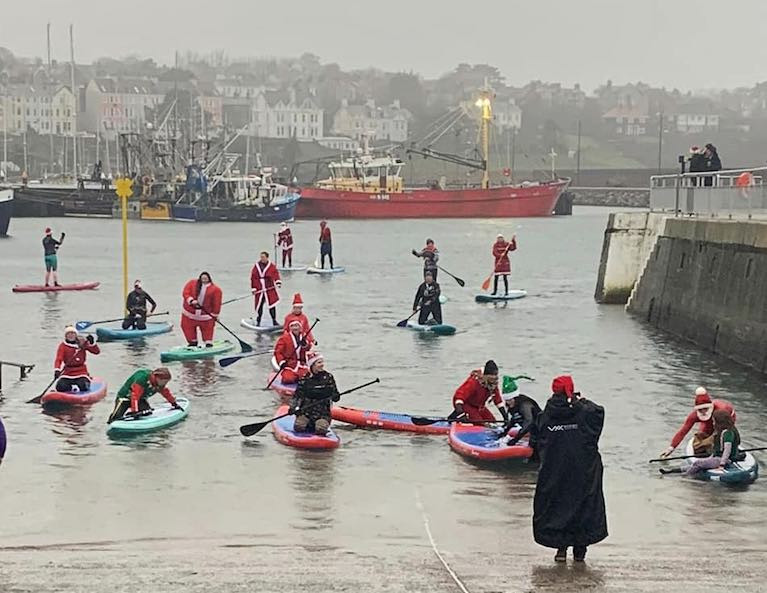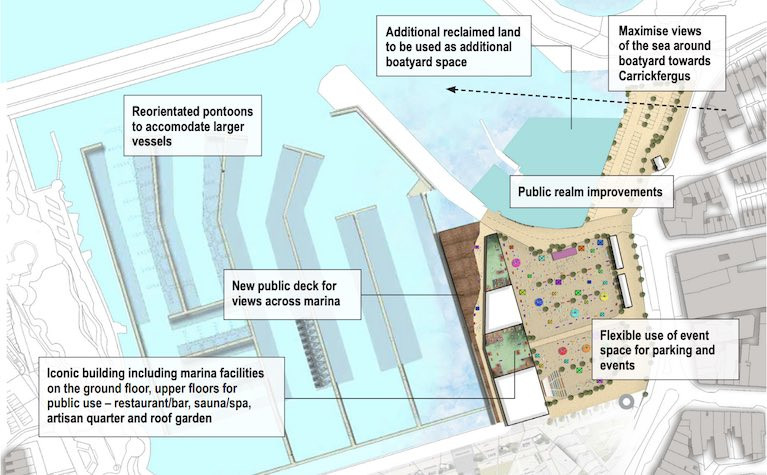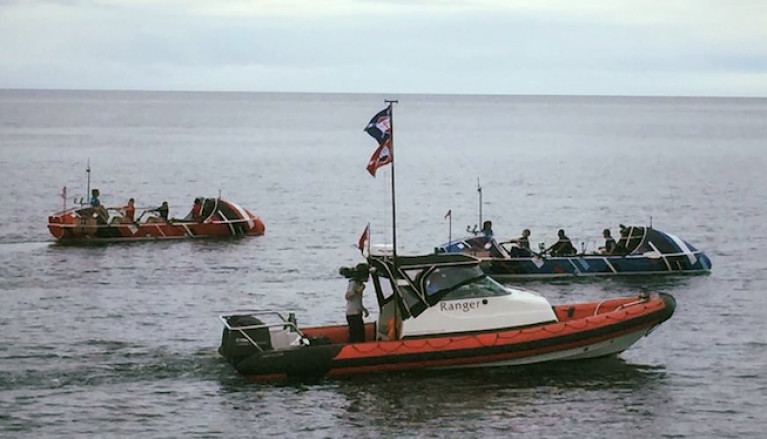Displaying items by tag: Bangor harbour
Praise from Bangor Harbour Master for North Down Littler Pickers
Litter is the scourge of many coastlines, and Bangor in North Down in Northern Ireland is no exception. But one person (and there are many) regularly litter picks in an adopted place (#AdoptASpot) on Seacliff Road, near the Long Hole beside the Harbour.
This month there seemed to be far less litter than normal during November.
Lesley Crawshaw said on Facebook it is “something to celebrate whilst it lasts. 1 bag lifted - 94 items. 11 sweet/snack wrappers/packets, 10 cans, 6 bottles, 4 bottle caps, 4 cotton bud sticks, 2 forks, 1 balloon, 1 lip gloss, 1 pen, 1 face mask, 1 tyre and the usual small pieces of broken-down plastic”.
Harbour Master Kevin Baird remarked, “Well done, Lesley - thank you for adopting a spot close to the Marina, Harbour and Long Hole”.
 One bag of litter lifted contained 94 items
One bag of litter lifted contained 94 items
'Spooky SUP' Halloween Social Paddle in Bangor Harbour
SUPhub NI is well known for its Santa SUP but this year the Halloween Social paddle in Bangor Harbour on Belfast Lough exceeded expectations as it was slotted in at short notice, taking advantage of a weather window on the evening of Sunday 30th when 28 paddlers braved the cold.
Iain McCarthy, who runs Suphub said “We were delighted with the turnout for such a last-minute event. Huge thanks to everyone who took part; even with such short notice, this was a cracking turnout with some particularly impressive costumes”. He continued – “Thanks also to the Lightfoot Zero Waste Market for the pumpkin soup and hot chocolate”.
 The Halloween Social paddle in Bangor Harbour on Belfast Lough had costume awards for all ages
The Halloween Social paddle in Bangor Harbour on Belfast Lough had costume awards for all ages
A double win in the race and costume awards went to Jilly Sykes, and Theo Hamilton won the Junior race.
£220 was raised for Bangor Lifeboat. Iain McCarthy added; “ Given that the lifeboat volunteer crew had just finished a 20-hour rotation SAR operation in Belfast Lough with multiple agencies, we were delighted to raise some money and show support for our local lifeboats”.
The next big dressing-up opportunity will be the 2022 Santa SUP on 3rd December, when it’s hoped that last year’s turnout of 96 will be beaten.
 £220 was raised for Bangor Lifeboat at The Halloween Social paddle in Bangor Harbour on Belfast Lough
£220 was raised for Bangor Lifeboat at The Halloween Social paddle in Bangor Harbour on Belfast Lough
Stand Up Paddleboard Santas in Bangor Harbour
Last week Jersey Coastguard was asked to go to the aid of a man dressed in red who reported that he had fallen out of his sleigh during a routine test flight and was stranded on a sandbank. Both RNLI St Helier Lifeboats were launched to assist the intriguing gentleman who was recovered safe and well.
It's good to know that there are people dressed in red suits who would have filled the gap had he not been rescued and 80 of these were seen yesterday braving the wind and driving rain in Bangor Harbour on Belfast Lough. In bubbles of up to 15 Santas, they took to the water in aid of the RNLI.
 Santa and snowman on board a Stand Up Paddleboard
Santa and snowman on board a Stand Up Paddleboard
Iain McCarthy who runs SuphubNI organised the event and he remarked " Stand-up paddleboarding is wonderful - cutting your way through the crystal clear waters of Bangor with the sun beating down on you, safe in your wetsuit and safety gear. Unfortunately, these were not the conditions that met our Santa SUP-pers yesterday, as the rain pelted down and the wind howled. Not enough to put people off though - and a great fun way to raise much-needed funds for RNLI Bangor".
 Santa on board Bangor RNLI Lifeboat
Santa on board Bangor RNLI Lifeboat
The paddle coincided with a training exercise for the lifeboat crew and they welcomed Santa on board, under the watchful eye of volunteer helm Gavin Mitchell.
All Change in £40m Plan for Bangor Waterfront on Belfast Lough
Bangor on Belfast Lough is hoping to secure through Ards and North Down Borough Council, around £40m from the Belfast City Regional Deal to fund the Bangor Waterfront Development and will submit the Outline Business Case to the Belfast Region City Deal in October. The outcome of the bid will be confirmed by the end of 2020 and if successful, the Council will contribute a further £20M approximately and the private sector about £4M to the project.
The Belfast Region City Deal (BRCD) offers a bespoke package of funding from Westminster to help achieve inclusive economic growth across the Belfast region, and the business case will detail concept proposals for five key regeneration projects.
This plan aims to redevelop a two-mile stretch of the seafront to re-establish Bangor as a thriving town and prime visitor attraction in Northern Ireland by connecting the waterfront to the rest of the town and, in so doing, provide a unique range of opportunities for residents and visitors to have their lives and businesses enriched by a mix of public spaces, creative events, activities, attractions and experiences that speak of local stories to a global audience.
 This plan aims to redevelop a two-mile stretch of the seafront to re-establish Bangor as a thriving town and prime visitor attraction in Northern Ireland
This plan aims to redevelop a two-mile stretch of the seafront to re-establish Bangor as a thriving town and prime visitor attraction in Northern Ireland
The projects encompass sections of the coastline. Skippingstone Beach, popular with sea swimmers, at the west end of the area and overlooking the entrance to the Harbour, will benefit from multi-use pods for beach activities, accessibility features, feature lighting/benches; Pickie Family Fun Park will be enhanced with new all-weather attractions for both children and young adults, and an extension to the Pickie Puffer train ride, which will take visitors from Pickie to the Queen's Parade area closer to the town centre. For Bangor Marina, the 530 berth Five Anchor facility right in the town centre, the proposals recommend redeveloping Bregenz House which houses the Coastguard Station and Marina office and facilities with, on the upper floors, bars, restaurants, an artisan corner and roof garden and a public deck offering views across the marina. Better public access around this building was a clear ask when the public surveys and stakeholder workshops on the development on Bangor Waterfront were undertaken.
In a comment about this particular part of the proposals, a spokesperson for the Council said "We have recognised this in the Outline Business Case (OBC) proposals but would stress that there are a number of steps to work through and matters to be considered before we can confirm whether Bregenz House will be redeveloped or not - most significant being approval of the OBC and provision of funding support from the Belfast Region City Deal. It is our hope that any redeveloped facility will include a range of users - new and existing, including the Coastguard. Initial discussions with the Coastguard indicate that they are keen to be part of the Bangor Waterfront Development plans and we will be engaging with them further as we move this exciting project forward".
 The Bangor town coastline
The Bangor town coastline
The regenerated Bangor Court House opposite the Harbour is earmarked for the Music Hub, a permanent home for the Open House Festival and a much-needed multi-purpose venue serving the town.
Moving east Kingsland, which began life as an amusement park in the early 20th century, is another green area between Bangor town and the suburb of Ballyholme currently with tennis courts, pitch and put and a dog park – here it is aimed to have café kiosks, a skate park and accommodation;
Nearby is Ballyholme Yacht Club which has been identified as the preferred location in Northern Ireland for major sailing and water sports events by the Royal Yachting Association. The redevelopment of BYC would provide Bangor with a world-class facility for water sports and the ability to host international events.
Welcoming the plans, Mayor of Ards and North Down, Councillor Trevor Cummings said: "Bangor has great potential. We need to build on its strengths, particularly its leisure and cultural assets, high-quality environment, and accessibility, to deliver sustainable regeneration. I would stress that these are proposals, rather than confirmed final plans".
Wayne Hemingway of Hemingway Design is part of the design team working on the Waterfront Development. He is co-founder of the fashion house Red or Dead and on the Design Council Chartered Association of Building Engineers (CABE) Committee. He commented " I was struck immediately on coming to Bangor by the beauty of the coastline and the potential in the town.
In designing the Waterfront Development, our research indicated that a series of attractions would offer more sustainable and inclusive benefits for Bangor than a single iconic attraction - particularly for those who live and work in the town".
Kevin Baird, Harbour and Marina Manager are enthusiastic." We are delighted with these concept proposals; they will ensure that the Bangor Waterfront will become a prime attraction for residents and visitors to Northern Ireland. Our vision of allowing safe access to the water for everyone is becoming a reality".
Sunken Motor Cruiser Forces Bangor Harbour Slipway Closure
A Notice to Mariners issued on 29th August by Bangor Harbour on Belfast Lough warns that the slipway in front of the Lifeboat house has been closed due to a sunken vessel.
On Wednesday night (26th August) the owners of a 27 ft approx Beneteau Antares reported while out fishing they had " hit something" and as they were taking on water took the boat back to their marina berth.
But the Marina staff inspection showed that it was actually sinking and so it was towed by the Harbour workboat, the Guillemot, to the slipway in front of the RNLI station. On arrival, it was virtually underwater and as two fire engines were unable to pump it out it was left secured to the jetty.
 A Bangor Harbour workboat towing the sinking vessel
A Bangor Harbour workboat towing the sinking vessel
Very strong winds on Friday (28th) blew the boat across the slipway against the Eisenhower Pier and the lifeboat was moved to a Marina berth.
 The sunken vessel alongside Bangor Harbour slipway jetty
The sunken vessel alongside Bangor Harbour slipway jetty
The Notice to Mariners states "The safety of Boat Owners, Paddle Boarders, Canoeists, Kayakers and Rowers who use the slipway is paramount. The slipway at Bangor Harbour is now closed. Bangor RNLI Lifeboat has been relocated to Bangor Marina – this is a temporary measure. The slipway will be reopened next week after the sunken vessel has been removed. Thank you for your cooperation".
'Don't Rock The Boat' Sets Sail from Bangor Harbour
Twelve celebrities are taking part in the challenge of a lifetime, to row the entire length of Britain, in a brand new, epic adventure series called 'Don't Rock The Boat'.
The 5 x 60-minute series will see 12 famous faces step out of their comfort zones and onto their sea legs as they compete in one of the toughest shows ever filmed on both land and sea.
British politician and author Tom Watson, sports presenter and Olympic gold medalist Denise Lewis OBE, supermodel and broadcaster Jodie Kidd, actor Craig Charles, singer-songwriter Fleur East, YouTuber Joe Weller, Love Island winner Jack Fincham, Coronation Street actress Lucy Fallon, Olympic, World and European Champion Victoria Pendleton CBE, The Chase's Dark Destroyer Shaun Wallace, actor and presenter Adam Thomas and International girl group, The Pussycat Dolls, member Kimberly Wyatt were in Bangor Marina this morning to start the N.Irish leg of the race.
 The 'Don't Rock the Boat' in Bangor Harbour
The 'Don't Rock the Boat' in Bangor Harbour
At 0930 they boarded their rowing boats and started to row from the Long Hole to Glenarm.
Taking the helm are sporting legend Freddie Flintoff and The Voice's AJ Odudu as they present the series and guide the celebrities through each leg of the race on the water and preside over the colossal coastal challenges on land.
Hooded Crows Cause a Stir Among Bangor's 'Black Penguins'
Black guillemots have been driven out of their long-time homes around Bangor harbour - by hooded crows.
BBC News reports that the crafty crows have been raiding nesting holes throughout the harbour, and have almost eliminated this year's brood of guillemots - affectionately known as 'black penguins'.
"Often there's been the odd egg or chick which has disappeared but this year it's been extraordinary,' said black guillemot expert Dr Julian Greenwood. "It's been a virtual wipe-out."
Dr Greenwood plans to thwart the crows next year by fixing small pieces of plywood across the openings of nesting holes, keeping the predators out.
BBC News has more on the story HERE.
































































